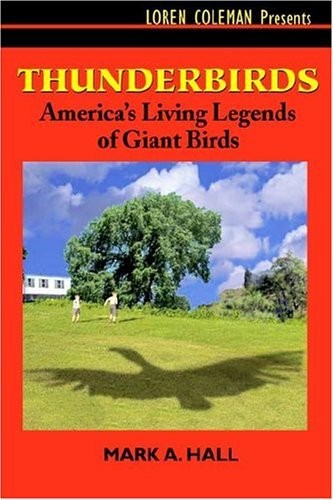
April 13, 2006
In response to my recent Cryptomundo posting about unusual birds showing up in North Dakota, cryptozoologist Matt Bille, author of Rumors of Existence

…and his forthcoming Spring 2006 sequel, Shadows of Existence, comments (remarks reproduced with permission) thusly:
When the topic of birds comes up, I always puzzle over the contrast between the amazing ability of birders to spot – and report – small accidentals and their apparent inability to spot Thunderbirds the size of Piper Cubs. With all respect to those who have done work in this field (Coleman, Hall, etc.) I remain convinced this is strong evidence no such birds exist.
Matt must have known that I would bring forth this quote: “Absence of evidence is not evidence of absence.” – Physicist John Archibald Wheeler via Carl Sagan’s book, A Demon Haunted World.
Needless to say, the simple answer to Matt’s remark is that birders are not looking for big birds because they don’t think they exist, there are few of the birds to see, and yet, of course, people are seeing the large birds, nevertheless.
Since Matt Bille is also addressing his critique to Mark A. Hall, I’ll let Hall speak for himself.

In Hall’s 2004 book, Thunderbirds: America’s Living Legends of Giant Birds, he writes:
Some critics of the survival of giant birds will argue that places like West Virginia have been thoroughly examined for birdlife and that no giant birds have been found. But that simply assumes the conclusion within their argument. The issue here is whether or not that assumption is in error. “Where are the reports of giant birds?” they will ask. That is what we are seeing here. Modern reports of giant birds continue. Why aren’t there more of them? Three reasons: the birds are not numerous; the birds are secretive and utilize the cover of darkness and their natural camouflage well…; and people are discouraged from making sightings known.
The ridicule factor has a major impact, and Hall goes on to give some commentary from one veteran birdwatcher who had this to say, in January 2003, about reporting unusual birds in Virginia:
As a long-time birdwatcher, I have learned that even when it comes to little things, like, say, a blue-gray gnatcatcher spending the winter in Virginia, most bird authorities won’t listen to you unless you file a detailed report, preferably with a good photo. I went on a Christmas bird count last year that yielded a black-and-white warbler and a gnatcatcher in Virginia during the month of December. The warbler was not taken seriously, even though it and another neotropical species had been found wintering in the same place the year before. God help someone who sees a boreal owl in Virginia.
In light of all this: I know folks who see rare owls, sandhill cranes, and the like in my neck of the woods, and don’t report them at all for fear of being laughed at by other birders. I’d imagine anyone who saw a Bachman’s warbler or ivory-billed woodpecker today would do the same. Even if the bird landed on your head, unless you had a good photo, not a soul would believe you. Even a respected expert in the field of ornithology would shudder at the idea of telling someone they saw one of these rare birds, especially if it were never seen again. Any evidence would be subject to ridicule. The bird in the photo is stuffed, the feather is from a pileated woodpecker or stuffed specimen, the call you heard was a starling or mockingbird’s mimic, yada yada yada…..It’s the same ridicule that keeps the thylacine in the shadows and lake monsters from being taken seriously by most scientists.
Why don’t birders see giant birds? Maybe they do, but they also are forestalled in reporting them through their formal channels. That’s more routine that apparently Bille wants to consider. Ridicule can be a strong deterrent to talking about something when people make you feel mentally unbalanced for saying you saw such things.
As Hall continues:
Thunderbirds are not understood and are not recognized for what they are in the bird-watching world. So when giant birds appeared over Illinois in 1977 no one in Illinois tried to track them at the time. No effort was set into motion to follow their progress through the state.
For now, as long as Thunderbirds remain part of cryptozoology’s “damned data,” they will stay in the cellar of the common birdwatcher’s priorities, and most birders will concentrate on their life lists and the accidentals they wish to record.
About Loren Coleman
Loren Coleman is one of the world’s leading cryptozoologists, some say “the” leading living cryptozoologist. Certainly, he is acknowledged as the current living American researcher and writer who has most popularized cryptozoology in the late 20th and early 21st centuries.
Starting his fieldwork and investigations in 1960, after traveling and trekking extensively in pursuit of cryptozoological mysteries, Coleman began writing to share his experiences in 1969. An honorary member of Ivan T. Sanderson’s Society for the Investigation of the Unexplained in the 1970s, Coleman has been bestowed with similar honorary memberships of the North Idaho College Cryptozoology Club in 1983, and in subsequent years, that of the British Columbia Scientific Cryptozoology Club, CryptoSafari International, and other international organizations. He was also a Life Member and Benefactor of the International Society of Cryptozoology (now-defunct).
Loren Coleman’s daily blog, as a member of the Cryptomundo Team, served as an ongoing avenue of communication for the ever-growing body of cryptozoo news from 2005 through 2013. He returned as an infrequent contributor beginning Halloween week of 2015.
Coleman is the founder in 2003, and current director of the International Cryptozoology Museum in Portland, Maine.
Filed under Books, Breaking News, Cryptotourism, CryptoZoo News, Cryptozoology, Eyewitness Accounts, Ivory-Billed Woodpecker, Mothman, Out of Place